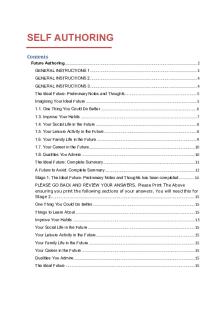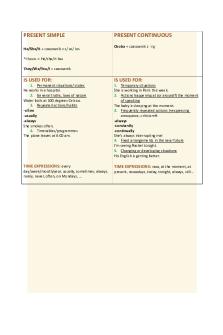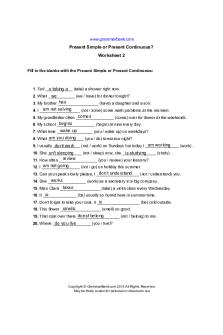SELF Authoring - Present Authoring - Faults PDF

| Title | SELF Authoring - Present Authoring - Faults |
|---|---|
| Author | Sunny Chahal |
| Course | Sport and Exercise Science |
| Institution | University of Birmingham |
| Pages | 23 |
| File Size | 464.6 KB |
| File Type | |
| Total Downloads | 30 |
| Total Views | 83 |
Summary
SELF AUTHORING Present Authoring: Faults Contents Faults Analysis Completing the Exercise Completing the Exercise Background Knowledge Plasticity Extraversion (Outgoing vs Reserved) Openness (Original vs Traditional) Stability Conscientiousness (Conscientious vs Carefree)...............................
Description
SELF AUTHORING Contents Present Authoring: Faults ................................................................................................................. 2 Faults Analysis ..................................................................................................................................... 2 Completing the Exercise 1................................................................................................................. 3 Completing the Exercise 2................................................................................................................. 4 Background Knowledge ..................................................................................................................... 5 Plasticity................................................................................................................................................... 5 Extraversion (Outgoing vs Reserved) ............................................................................................. 5 Openness (Original vs Traditional) .................................................................................................. 6 Stability .................................................................................................................................................... 6 Conscientiousness (Conscientious vs Carefree)........................................................................... 6 Emotional Stability (Calm vs Nervous)............................................................................................ 6 Agreeableness (Agreeable vs Assertive/Aggressive)................................................................... 7 Impact of Personality Traits .............................................................................................................. 7 Change .................................................................................................................................................... 7 Extraversion/Introversion ...................................................................................................................... 9 Select Relevant Items ........................................................................................................................ 9 Openness/Traditionalism .................................................................................................................... 10 Select Relevant Items ...................................................................................................................... 10 Conscientiousness/Carelessness...................................................................................................... 11 Select Relevant Items ...................................................................................................................... 11 Emotional Stability/Low Stress Tolerance ........................................................................................ 13 Select Relevant Items ...................................................................................................................... 13 Agreeable/Assertive............................................................................................................................. 14 Select Relevant Items ...................................................................................................................... 14 HABIT SELECTION ............................................................................................................................ 15 Prioritize Your Selection .................................................................................................................. 17 Describe an Experience ...................................................................................................................... 19 Fault: (Write Your Selected FAULT Here):.......................................................................................... 19
Alternative Outcome ............................................................................................................................ 19 Fault: *SAME AS ABOVE* .............................................................................................................. 19 Guidelines for general improvement ................................................................................................. 20 Fault: *SAME AS ABOVE* .............................................................................................................. 20 Describe an Experience ...................................................................................................................... 21 Fault: (Write Your Selected FAULT Here):.......................................................................................... 21 Alternative Outcome ............................................................................................................................ 21 Fault: *SAME AS ABOVE* .............................................................................................................. 21 Guidelines for general improvement ................................................................................................. 22 Fault: *SAME AS ABOVE* .............................................................................................................. 22
Present Authoring: Faults Welcome to the Present Authoring: Faults component of the Self-Authoring suite. This exercise has been designed to allow you to do an in-depth analysis of some of the negative aspects or faults of your personality.
The exercise may take up to three hours to complete. You may quit the exercise any time by clicking Exit/Home or shutting down your browser. If the current page is a page you have been writing on, remember to click Save before exiting. The text that you entered on previous pages will have already been saved.
You can come back to the exercise later, and resume your work. Just go to www.selfauthoring.com, click the Subscriber Login button (top right) and choose the Present Authoring: Faults exercise. When you return, all your previous work will be waiting for you, and you will be taken to the last point in the exercise you had completed.
Faults Analysis
This program has been designed to allow you to do an in-depth analysis of some of the negative aspects or faults of your personality. It is the partner program to the virtues analysis section of the present authoring program. It is our hope that constructing a clearer picture of your faults will help you understand the impact of your personality traits on your life in the past, present, and future.
It is probably best to complete this exercise if you are in a normal to good mood, so that you can tolerate the self-criticism. If you are feeling sad, lonely, or depressed, you should probably do the virtues analysis instead. This exercise will take you 60-90 minutes, depending on your choices. You will be asked first to read some information about basic personality theory and then to select 2-10 faults from each of five lists of faults (one list per basic personality trait).
Then you will be presented with the faults you have selected, and asked to choose a final list of the faults you think have most interfered with your life. You will be asked to write for about 10 minutes, later, for each fault you choose, after you have rank-ordered them in importance. We recommend that you choose 6-9 faults (for 60 to 90 minutes of work), but you can choose as many as you like. Just remember that you will be asked to write about each one. You will be asked to describe how this fault has impacted you negatively, in the past; what you might have done differently; and what you could do now and in the future to rectify or eliminate this fault.
Completing the Exercise 1 During this exercise, you will be presented with a series of pages either providing you with information, or asking you to describe aspects of your personality and experiences.
You may proceed through the exercise by clicking the Next button.
You can go back to previous pages by clicking Previous.
Each time you click Next or Previous, the data you have entered on that page will be saved. You can also save your data while remaining on the same page by clicking Save. In addition, many of the pages where you are asked to write for longer periods of time will automatically save every minute or so.
You may quit the exercise any time by clicking Exit/Home or shutting down your browser. If the current page is a page you have been writing on, remember to click Save before exiting. The text that you entered on previous pages will have already been saved.
You can come back to the exercise later, and resume your work. All your previous work will be waiting for you, and will be taken to the last point in the exercise you had completed.
Completing the Exercise 2 On many pages, you will not be able to successfully click Next or Previous unless you have provided a minimum of necessary text. If you do not, you will receive an error message, and the text box in question will be highlighted in red.
Text boxes also have a maximum length. Pay attention, as you write, to the numbers above the text boxes. Numbers like [180 / 1000] indicate that you have typed 180 characters out of a maximum allowable of 1000. When you go over the maximum, the numbers above the text box become red. Clicking Next, Previous, or Save will result in an error message and you will not be able to proceed to the Next or Previous page. To resolve this, edit your text until the number of characters is less than or equal to the maximum. These limitations have been established so that you do not get stalled at any point in the process.
We do encourage you to write in some detail, however, subject to those limitations. Our research indicates that better results are obtained as the amount written by participants increases.
There is a progress bar in the top right portion of the screen, which displays the percentage of the exercise that you have already completed. If you hover over the bar with the mouse, you can see approximately how much time it will still take to complete the exercise.
You may use the Index to jump to any page you have already completed. Clicking the [Index] link will open the index. Clicking it again will close it. Remember to click Save to save any work on the current page before using the index to jump to another page.
After you have completed the exercise, you will be taken to a Summary page. You can use that page to email yourself a copy of your writing.
Background Knowledge To complete the following exercise, there are a number of things that are useful to know. (you may have encountered this information previously if you have completed the virtues analysis program, but it might be worthwhile to review it):
Everybody's personality is composed of two higher-order traits. The first higher-order trait is known as plasticity, and can be thought of as the tendency to be flexible, exploratory, curious, and quick to adapt. The second higher-order trait is known as stability, and can be thought of as the tendency to be structured, organized, emotionally stable and focused.
Plasticity Plasticity, the first higher-order trait, can be further broken down into two sub-traits: Extraversion (the tendency to be enthusiastic and dominant) and Openness (the tendency to be open-minded and intelligent).
Extraversion (Outgoing vs Reserved)
Sociable
Active
Adventurousness
Positive
Excitement-Seeking
Gregarious
Openness (Original vs Traditional)
Fantasy-prone
Aesthetically-minded
Philosophical
Creative
Intuitive
Intellectual
Stability Stability, the second higher-order trait, can be further broken down into three sub-traits: Conscientiousness (the tendency to be orderly and industrious), Emotional Stability (lack of negative emotional volatility and the tendency to withdraw), and Agreeableness (politeness and compassion, as opposed to belligerence or aggression).
Conscientiousness (Conscientious vs Carefree)
Competent
Orderly
Decisive
Achievement-oriented
Self-disciplined
Deliberate
Industrious
Emotional Stability (Calm vs Nervous)
Anxious (reversed)
Angry (reversed
Hostile (reversed)
Depressed (reversed)
Self-Conscious (reversed)
Vulnerable (reversed)
Agreeableness (Agreeable vs Assertive/Aggressive)
Warm
Trusting
Straightforward
Altruistic
Modest
Compliant
Tender-minded
Nice
Impact of Personality Traits There are advantages and disadvantages to each trait, particularly at the extremes. Extremely sociable, extraverted people can be dominant and impulsive, while introverted, quiet people can easily become isolated and depressed. Extremely open people can be scattered and overwhelmed by their own thoughts and ideas, while closed-minded people may become narrow and inflexible. Exceptionally conscientious people can be obsessive about order, judgemental and rigid, while their more carefree counterparts may be messy, undisciplined and careless. People very high in emotional stability may engage in risky, dangerous behavior, while those who are more neurotic can become so preoccupied by anxiety and pain that they are unable to function. Finally, extremely agreeable people may never stand up for themselves, while those who are too assertive can be aggressive, callous and bullying.
Change Personality is reasonably stable over the lifespan, and is also powerfully influenced by hereditary or genetic factors. Despite this, personality can broaden or even transform. As people age, for example, they tend to become more agreeable, conscientious and emotionally stable. Changing personality means changing habits of action, presumption and perception. Personality change requires the formulation of clear future goals, as well as discipline and practice. People who
are too agreeable can learn to stand up for themselves. Disorderly people can become more conscientious. Introverted people can become socially skilled. People who experience paralyzing levels of negative emotion can learn to explore.
Extraversion/Introversion Select Relevant Items Please select habits that apply to you. You can select up to 10 habits, and are required to select at least 2. Be over-inclusive. Don’t worry if some of the bad habit descriptions do not really apply, as you will get to specify the most typical habits later, when you make your final fault selection, prior to writing.
Please select between 2 and 10 habits
Sometimes act without thinking Sometimes talk too loudly Can spend too much money May exaggerate the truth May dominate the conversation excessively Find it difficult to spend time alone Could be a better listener May spend too much time pursuing fun and excitement May attract too much attention to myself Do not let the quieter people have a chance to talk Try too hard to be the center of attention Can be too theatrical or dramatic May be too dependent on the admiration or attention of others Can be a little grandiose Talk about myself a lot Often feel uncomfortable around others Keep in the background Have too little to say Lose opportunities because I am too isolated Am too quiet around strangers Find it difficult to approach othe rs
Don't laugh much or have fun Bottle up my feelings Am a very private person Wait for others to lead the way Feel drained by social interactions Am not very enthusiastic Could be more socially skilled Have a difficult time starting conversations Have a social circle that is too small
Openness/Traditionalism Select Relevant Items Please select habits that apply to you. You can select up to 10 habits, and are required to select at least 2. Be over-inclusive. Don’t worry if some of the bad habit descriptions do not really apply, as you will get to specify the most typical habits later, when you make your final fault selection, prior to writing.
Please select between 2 and 10 habits
Pursue too many activities at the same time Am interested in so many things that I don't know what to focus on Have a hard time planning for the future because I am interested in everything Am sometimes attracted by ideas that are radical but have not been thought through Sometimes see meaning in things that probably isn't there Jump around too much from topic to topic when I am talking to people Have a hard time making up my mind because I can always see all the sides of an argument Am so interested in creative activities that it is hard to concentrate on things that are practical Can become possessed by an idea Daydream too much
Sometimes every thought I have immediately suggests an overwhelming number of ideas Have had experiences or thoughts that were strange enough to frighten me Have had a hard time forming a clear identity See connections between things too easily Have done crazy things just because I was curious about what might happen Am good at a too-narrow range of things Am seldom interested in abstract, philosophical ideas Avoid sophisticated fiction and stories Do not attend movies or plays Am unimaginative Do not care for change Do not involve myself in creative activities Do not like to read challenging material Do not really understand or value art Seldom seek out new experiences Try to avoid complex people Will not probe deeply into a subject Am unlikely to initiate a new project Tend to think that creative people are strange Always do things the same way once I have learned how to do them
Conscientiousness/Carelessness Select Relevant Items Please select habits that apply to you. You can select up to 10 habits, and are required to select at least 2. Be over-inclusive. Don’t worry if some of the bad habit descriptions do not really apply, as you will get to specify the most typical habits later, when you make your final fault selection, prior to writing.
Am too perfectionistic Get obsessed with details and lose the big picture Insist that everything be in perfect order Dislike deviation from the rules, even when it is necessary Have to plan everything Seriously dislike having my routine or schedule upset Cannot stand to be late for an appointment Feel that I am being unproductive if I relax Can be very judgemental Get upset at myself when I misplace something Will work on a project beyond what is useful and necessary Believe that I have to be flawless Always believe that failure is a consequence of insufficient personal effort Cannot tolerate having to finish a task imperfectly or quickly Can be contemptuous of other people and of myself Do things in a half-way manner Don't like to tidy up Find it difficult to get down to work Make a mess of things Leave my belongings around Surf the web or watch TV or waste time in other ways even if I have a project due Am without real ambition Neglect my duties Frequently make excuses Often procrastinate Waste my time Am sometimes willing to bend the truth to get out of an obligation Feel unmotivated to complete my work Have few clearly defined goals Have no stable dai...
Similar Free PDFs

SELF Authoring - Future Authoring
- 34 Pages

Future Authoring Program
- 21 Pages

Present Progressive
- 2 Pages
Popular Institutions
- Tinajero National High School - Annex
- Politeknik Caltex Riau
- Yokohama City University
- SGT University
- University of Al-Qadisiyah
- Divine Word College of Vigan
- Techniek College Rotterdam
- Universidade de Santiago
- Universiti Teknologi MARA Cawangan Johor Kampus Pasir Gudang
- Poltekkes Kemenkes Yogyakarta
- Baguio City National High School
- Colegio san marcos
- preparatoria uno
- Centro de Bachillerato Tecnológico Industrial y de Servicios No. 107
- Dalian Maritime University
- Quang Trung Secondary School
- Colegio Tecnológico en Informática
- Corporación Regional de Educación Superior
- Grupo CEDVA
- Dar Al Uloom University
- Centro de Estudios Preuniversitarios de la Universidad Nacional de Ingeniería
- 上智大学
- Aakash International School, Nuna Majara
- San Felipe Neri Catholic School
- Kang Chiao International School - New Taipei City
- Misamis Occidental National High School
- Institución Educativa Escuela Normal Juan Ladrilleros
- Kolehiyo ng Pantukan
- Batanes State College
- Instituto Continental
- Sekolah Menengah Kejuruan Kesehatan Kaltara (Tarakan)
- Colegio de La Inmaculada Concepcion - Cebu












